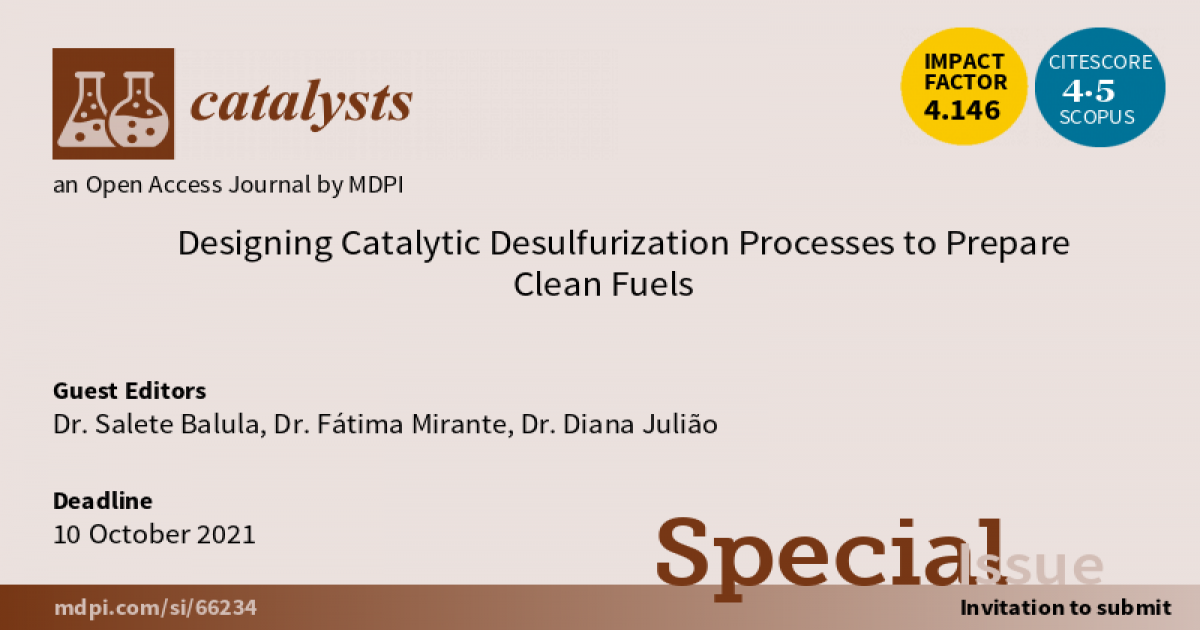Designing Catalytic Desulfurization Processes to Prepare Clean Fuels
A special issue of Catalysts (ISSN 2073-4344). This special issue belongs to the section "Environmental Catalysis".
Deadline for manuscript submissions: closed (30 April 2023) | Viewed by 22471

Special Issue Editors
Interests: heterogeneous catalysts; polyoxometalates; catalytic metal–organic frameworks; sustainable catalytic processes; oxidation catalysis; hydrogen peroxide; desulfurization; glycerol oxidation; deep-eutectic solvents
Special Issues, Collections and Topics in MDPI journals
Interests: eco-sustainable catalytic systems; heterogeneous catalysis; sulfur compound oxidation; desulfurization processes; polyoxometalate (POM); silica functionalized materials; glycerol oxidation
Special Issues, Collections and Topics in MDPI journals
Special Issue Information
Dear Colleagues,
Sulfur compounds in fuels are the main reason for acid rain and environmental pollution. The combustion of fossil fuels generates emissions of sulfur such as sulfur dioxide (SO2), which is corrosive and toxic, and as fine particulate matter of metal sulfates. In response to this, the specifications of govern transportation fuels have been increasing severely with respect to sulfur content over the years. The strict regulations imposed have required the development of novel technologies with higher cost efficiency and sustainability, adapted to a variety of different fuels, presenting distinct properties and sulfur contents. The actual desulfurization method in the world refineries, i.e., hydrodesulfurization, has been adjusted to meet the tight specifications of the current limit imposed by government directives; however, the extreme severe conditions required (high temperature, pressure, and consumption of large amounts of hydrogen) are affecting the economic viability of the process. On the other hand, the hydrodesulfurization process is unviable to treat certain types of fuels, such as heavy fuel oil.
Catalytic processes can be used to improve or even replace the actual hydrodesulfurization. Therefore, this Special Issue aims to outline promising catalytic desulfurization technologies to treat fuels, designing novel cost-effective and sustainable processes. These can include biocatalysis, extractive, oxidation, adsorptive processes, etc., with viability for industrial application. Submissions are welcome in the form of original research manuscripts or critical review papers that represent the scientific field.
Dr. Salete Balula
Dr. Fátima Mirante
Guest Editors
Manuscript Submission Information
Manuscripts should be submitted online at www.mdpi.com by registering and logging in to this website. Once you are registered, click here to go to the submission form. Manuscripts can be submitted until the deadline. All submissions that pass pre-check are peer-reviewed. Accepted papers will be published continuously in the journal (as soon as accepted) and will be listed together on the special issue website. Research articles, review articles as well as short communications are invited. For planned papers, a title and short abstract (about 250 words) can be sent to the Editorial Office for assessment.
Submitted manuscripts should not have been published previously, nor be under consideration for publication elsewhere (except conference proceedings papers). All manuscripts are thoroughly refereed through a single-blind peer-review process. A guide for authors and other relevant information for submission of manuscripts is available on the Instructions for Authors page. Catalysts is an international peer-reviewed open access monthly journal published by MDPI.
Please visit the Instructions for Authors page before submitting a manuscript. The Article Processing Charge (APC) for publication in this open access journal is 2200 CHF (Swiss Francs). Submitted papers should be well formatted and use good English. Authors may use MDPI's English editing service prior to publication or during author revisions.
Keywords
- Sulfur compounds Catalysts Desulfurization processes Clean fuels Materials
Benefits of Publishing in a Special Issue
- Ease of navigation: Grouping papers by topic helps scholars navigate broad scope journals more efficiently.
- Greater discoverability: Special Issues support the reach and impact of scientific research. Articles in Special Issues are more discoverable and cited more frequently.
- Expansion of research network: Special Issues facilitate connections among authors, fostering scientific collaborations.
- External promotion: Articles in Special Issues are often promoted through the journal's social media, increasing their visibility.
- Reprint: MDPI Books provides the opportunity to republish successful Special Issues in book format, both online and in print.
Further information on MDPI's Special Issue policies can be found here.






